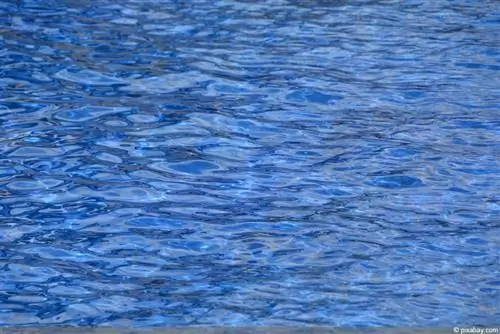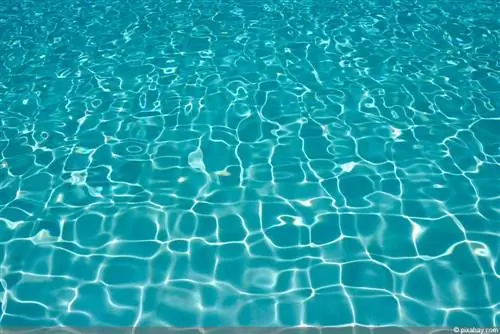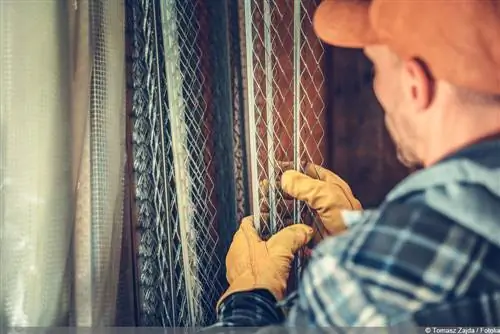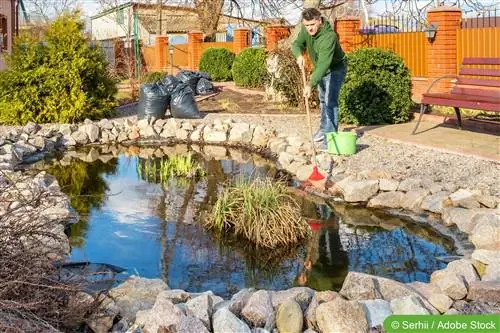- Author admin [email protected].
- Public 2023-12-17 03:39.
- Last modified 2025-01-24 12:45.
Having your own pool in the garden is a nice thing in summer. Not only does it cool you down on hot days, but it's also a lot of fun. However, it must be thoroughly cleaned before being put into operation in the spring. In addition, it is important to check the technology if you do not want to spoil your bathing pleasure later in the year. Here are a few tips.
Winter rest
Only really hard-core people go swimming outside in winter. As a result, a pool is not used during the cold season. Rather, you give it a kind of hibernation. It is recommended to cover it completely during this rest phase. This can be done with a tarpaulin, an inflatable rubber cover or even with metal or plastic plates. Such a cover not only prevents animals from accidentally falling into the pool, but also significantly reduces the entry of dirt. As a pool owner, you will be grateful for such a cover in spring at the latest when the pool needs to be cleaned - it saves you a lot of effort and work. However, it is not necessary to completely empty the pool in winter. However, all pipes and supply and drainage lines should be free of water to avoid frost damage.
Note:
Technical devices such as heat and circulation pumps as well as accessories such as an access ladder should definitely be removed and stored during winter rest for safety reasons.
Preparing for spring cleaning
If it is guaranteed that there will no longer be extended frost nights, you can start preparing the pool for re-use in the spring. The core element of preparation is thorough cleaning of the pool. To do this, it must first be completely emptied if water has remained in it during the winter. The following devices and utensils are useful for cleaning measures:
- High-pressure cleaner
- Dirty water pump
- Cleaning brush
- Extractor wiper
- Cleaning supplies
- Bucket
- Rubber gloves
- Freshwater

If you don't have a high-pressure cleaner or a dirty water pump yourself, you can rent the devices for an hour or a few days from a hardware store for a fee. Their use is particularly recommended for larger pools. The main purpose of the pump is to remove water residue that arises as a result of cleaning. The cleaning products for the bottom and walls of the pool should have a rather acidic orientation in order to be able to remove limescale deposits and the common deposits of metal oxides. Black edges in the upper area of the basin, however, disappear more easily with an alkaline cleaner.
Note:
Conventional household cleaners are generally not suitable for cleaning the pool. It's best to get special pool cleaners from specialist pool supply stores and follow the manufacturer's dosage instructions exactly.
When handling the cleaning products, you should definitely wear rubber gloves to avoid possible skin irritation. The brush and bucket are primarily used for fine cleaning and cleaning of pipes and inlets. Furthermore, you should be aware that when using a high-pressure cleaner in the pool, there is a high risk that your clothes will get wet. The water for all cleaning measures should come from the public water supply and not from a well in the garden.
Cleaning specifically
Before you start cleaning the pool, all plugs installed for winter rest must first be removed. The high-pressure cleaner is then used. The best way to do this is to go into the pool with the device, as this makes the work much easier. The respective cleaner is tipped directly into the water reservoir of the high-pressure cleaner. This is how you proceed with cleaning:
- start with the walls
- always irradiate them over a large area from top to bottom
- also radiate into supply lines and other openings
- then clean the floor over a large area
Rests of dirty water that remain on the floor are removed using the dirty water pump. The work is then reworked again with the high-pressure cleaner. Alternatively, a scrubber can also be used here. Finally, the fine cleaning takes place. Here, inlets and other openings in particular are thoroughly cleaned with a brush and a mixture of cleaner and water. Once this is done, the pool should be clean. In the case of very stubborn dirt, the entire cleaning process may have to be repeated.
Algicides
Before the cleaned pool is filled with water again and put into operation, the walls and floor of the pool should be subjected to a special treatment. In order to prevent or make it more difficult for algae to form in the water later, it is recommended to apply a so-called algicide. This is also available from specialist pool supply stores. It is either brushed on with a brush or sprayed over a large area. In order to rule out respiratory diseases, it is advisable to wear a simple protective mask. In principle, you should not skimp on algicide. Because: Fighting algae later usually requires the pool to be completely cleaned again.
Note:
The algicide is often first mixed with fresh tap water. It is imperative to follow the manufacturer's dosage instructions.
Commissioning
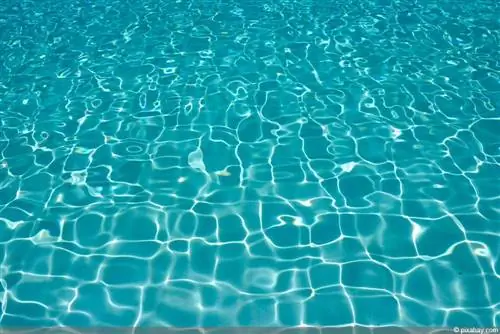
Before the pool is filled with water, the screws for the drainage should first be greased with Vaseline. To do this, remove the screws, coat them with Vaseline and then reinsert them. Then it's the turn of the filter pump. It may only be switched on once it has been completely filled with water. Without this water filling, significant damage to the device can occur. Once the entire pump system is filled with water, you start with a flush. This is done simply by turning the pump on and then keeping it running for around five minutes. This should be followed by a one-minute rinse - only then is the system free of all residues and dirt.
Note:
The manufacturer's instructions must be followed when rinsing and cleaning the filter pump. These may differ from the measures listed above.
Only when the filter pump is really ready for use can you start filling the basin with water. The public water supply should always be used here. The water must be of drinking water quality. However, water from a well in the garden does not meet this requirement. In addition, it often contains contamination that would dirty the pool again the first time it was filled.

